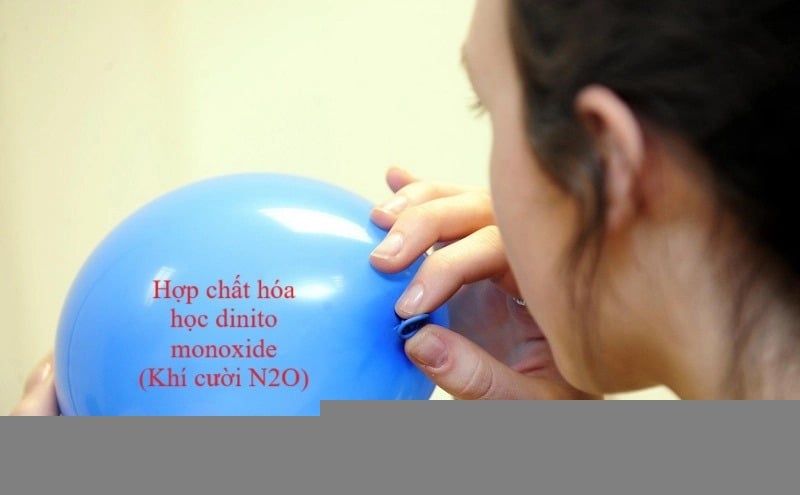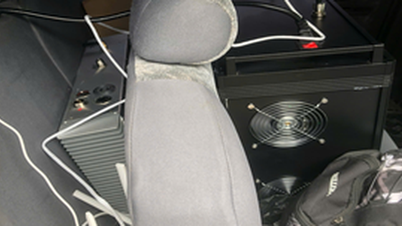In recent years, "laughing gas" - a hobby that is popular among many young people - has become a serious threat to public health.
Our country prohibits the production, trading, import, transportation, storage and use of laughing gas from January 1, 2025. |
Known as a means of creating excitement, balloons containing N2O (dinitrogen oxide) gas can bring a feeling of "high" and comfortable laughter, but the consequences behind it cannot be ignored. A series of cases of N2O gas poisoning, serious nerve damage and even death have raised necessary warnings about the abuse of laughing gas.
Recently, a 22-year-old male patient in Ho Chi Minh City had to be hospitalized because of numbness in his limbs that lasted for two months, along with muscle weakness and difficulty moving.
After examining and taking a medical history, the doctor discovered that this young man had a habit of using laughing gas with a frequency of up to 20-60 balls per week. The abuse of laughing gas caused numbness in both hands and feet, especially the fingers, along with decreased muscle strength in the upper limbs, making it difficult for him to perform daily activities.
According to doctors at the University of Medicine and Pharmacy Hospital in Ho Chi Minh City, where the patient was treated, this is a typical case of N2O gas poisoning, which seriously affects the nervous system. The patient has been treated with vitamin B12 supplements, nerve function rehabilitation and lifestyle adjustment.
Laughing gas, also known as Funky Ball, is currently a "trend" chosen by many young people in gatherings, especially at bars, discos, or even sidewalk cafes. However, few people know that the N2O gas in laughing gas is not simply a temporary stimulant but also poses extremely serious health risks.
N2O gas initially produces feelings of euphoria, euphoria, and even unbridled laughter when inhaled, but the long-term effects of excessive use can adversely affect the central nervous system.
Common symptoms of laughing gas abuse include numbness, weakness in the limbs, damage to the cervical spinal cord, and peripheral polyneuropathy. If left untreated, this condition can lead to paralysis, coma, and even death.
Previously, another case, patient NMN (23 years old, Hanoi ), came to Medlatec Thanh Xuan General Clinic with numbness in the limbs, tingling sensation in the extremities, headache, prolonged insomnia, anxiety and rapid heartbeat.
The doctor determined that this was the result of continuous use of laughing gas for a year, about 3 times a week. Tests and imaging showed that the patient had nerve damage due to N2O gas poisoning, with cervical disc degeneration and peripheral polyneuropathy.
Laughing gas abuse not only causes nerve damage but also has negative effects on other organs in the body. Inhaled N2O gas causes the body to lack oxygen, affecting the functions of the heart, brain and other important organs. Consequences from using laughing gas can cause neurological disorders, convulsions, depression, loss of sensation, motor paralysis and even death.
Vietnam has decided to ban the production, trading, import, transportation, storage and use of laughing gas from January 1, 2025. This decision was made in the context that laughing gas is increasingly becoming a danger not only to health but also negatively affecting the development of young people.
Doctors and health experts advise young people not to use laughing gas, emphasizing that abusing this substance can have serious long-term consequences. A healthy lifestyle, avoiding stimulants and dangerous entertainment such as laughing gas will help protect the health and future of each person.
Source: https://baodautu.vn/he-luy-nguy-hiem-cua-bong-cuoi-khi-niem-vui-tro-thanh-con-ac-mong-d265372.html





![[Photo] Prime Minister Pham Minh Chinh chairs the conference to review the 2024-2025 school year and deploy tasks for the 2025-2026 school year.](https://vphoto.vietnam.vn/thumb/1200x675/vietnam/resource/IMAGE/2025/8/22/2ca5ed79ce6a46a1ac7706a42cefafae)


![[Photo] President Luong Cuong attends special political-artistic television show "Golden Opportunity"](https://vphoto.vietnam.vn/thumb/1200x675/vietnam/resource/IMAGE/2025/8/22/44ca13c28fa7476796f9aa3618ff74c4)





















































































Comment (0)